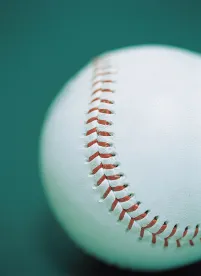Who's First in Ownership of the "Sweet Spot" Remains Unclear
Baseball is often called a "game of inches," whether one is describing the strike zone, a close play at the plate, or a liner past third base that just kicks up the chalk to stay fair. Indeed, hitting is truly about inches. Pitchers try to locate their pitches on the edges of the plate or have them run just out of the strike zone to prevent the batter from making contact with the "sweet spot" of the bat – a ball struck just off the main part of barrel might result in a soft fly to shortstop, while the same swing where the ball contacts the sweet spot of the bat might result in a smash to the outfield gap. In wooden bats, the sweet spot is generally located in the area above the manufacturer's label, about 5-7 inches from the end of the barrel (essentially, the node on the bat that results in minimal vibration when striking a ball). Employing the physics principle of Coefficient of Restitution (COR), the more a baseball bat vibrates upon impact with the ball, the more energy the bat retains, resulting in less energy returned to the ball after collision (and a stinging feeling in the batter's hands); conversely, the less a bat vibrates, the more kinetic energy is transferred to the ball, resulting in the ball travelling a greater distance.
Metal bats are hollow and work a little bit differently, as they are lighter (resulting in a faster swing) and bend slightly upon impact with the ball (i.e., the trampoline effect), causing the ball to travel farther and faster from the crack (or ping) of the bat. As a result, baseball and softball associations have established metal bat performance standards based upon the bat's particular COR at the barrel, setting a maximum COR that minimizes the trampoline effect and the speed of the ball off the bat. The engineering trick is how to modify a metal bat's design to fit within the guidelines, but without making the bat too heavy or overly reducing its performance outside of the sweet spot zone. It is this innovation that was the subject of a patent infringement suit between two sporting goods companies, Easton Baseball/Softball Inc. ("Easton") and Wilson Sporting Goods ("Wilson"). (Easton Baseball/Softball Inc. v. Wilson Sporting Goods Co., No. 15-9221 (C.D. Cal. filed Nov. 30, 2015)).
Going to bat for its own IP, Easton sued Wilson for allegedly infringing its patents (Nos. 8,480,519 and 8,795,108) on a baseball bat with "governed performance" – essentially, a bat design that included stiffening and dampening elements positioned between the sweet spot and the handle to "selectively reduce the barrel's performance without appreciably increasing the bat's moment of inertia." Easton claimed that Wilson produced bats that unlawfully used Easton's patented stiffening element. In its defense, Wilson argued that there was ambiguity with how the patents defined the term "sweet spot" and that the stiffeners in its allegedly infringing bats were not located in the positions claimed in the patents-at-issue. In a battle of experts, the parties engaged in a pitching duel over whether the term "sweet spot" referred to a location based upon points of vibration within the bat or merely as the spot of "maximum performance location" and whether the experts were qualified or even conducted sufficient testing to determine if infringement occurred.
Notably, in its motion for partial summary judgment, Wilson also argued that one of Easton's patents was invalid due to the presence of prior art – in fact, Wilson claimed that its own Ultimate Fastpitch Bat (UFB), released about seven years prior to the priority date of one of Wilson's patents, used stiffening elements made of cork between the sweet spot and the handle that anticipated all of the claims of Easton's patented design.
And here's the pitch… Unfortunately, we will never discover if the court would have found infringement or else batted away Easton's claims. With the trial date looming, the parties settled the matter and stipulated to the dismissal of the action (perhaps, Easton did not want to risk an order of invalidity of one of its patents, while Wilson wished to avoid a potential large damage award). Thus, in this bat design litigation of inches, the parties deemed it better to take a pitch rather than swing away.
Fitness Club "Spotted" by Exculpatory Clause in Membership Agreement
If you operate a health club, it pays to make sure your membership agreements are in good shape.
Gym chain LA Fitness was sued by member Patricia Evans in 2015 over injuries sustained from a fall during a training session. On September 28, 2016, a Pennsylvania federal court granted summary judgment to Fitness & Sports Clubs, LLC (doing business as LA Fitness), finding that the gym is protected by waivers of liability in the membership and personal training agreements that Evans signed. (Evans v. Fitness & Sports Clubs, LLC, No. 15-4095 (E.D. Pa. Sept. 28, 2016)).
Evans, who was 61 at the time of the fall, alleged that she fell and fractured both her wrists during a personal training session at a Pennsylvania LA Fitness location. She alleged that her personal trainer urged her to go faster while performing "suicide runs," which required her to repeatedly run forward, bend down to touch a weight then run back to the start line.
LA Fitness argued that two exculpatory clauses in each of the membership and personal training agreements signed by Evans shield LA Fitness and its trainer from liability. The membership agreement, which an LA Fitness employee "perused through" with her, included a release and waiver of liability and indemnity, an exculpatory clause, and an arbitration clause. As the evidence showed, Evans signed the first page of the Membership Agreement, initialed in two places on the second page, and initialed the bottom of the third page. Directly above the signature line on the first page of the Membership Agreement, the following language appears in a text box:
"By signing this Agreement, Buyer acknowledges that Buyer is of legal age, has received a filled-in and completed copy of this Agreement has read and understands the entire agreement including but not limited to (1) the RELEASE AND WAIVER OF LIABILITY AND INDEMNITY…"
On the second page of the Membership Agreement, a text box near the top of the page contained an exculpatory clause and an arbitration clause printed in larger font than the rest of the text on the page that began: "IMPORTANT: RELEASE AND WAIVER OF LIABILITY AND INDEMNITY."
Months after signing the initial Membership Agreement, Evans also signed the Personal Training Agreement, which included similar language concerning assumption of risk, limitations of liability, and an arbitration clause.
Refusing to be boxed in, Evans contended that she did not knowingly waive liability and that the clauses were not conspicuously displayed on the agreements. However, before Evans signed the membership and personal training agreements, an LA Fitness employee discussed the agreements with Evans. Moreover, each agreement included an acknowledgment that Evans had read and understood the entire agreement, placed directly above Evan's signature.
LA Fitness moved for summary judgment on the basis that the exculpatory clauses in the membership and personal training agreements were enforceable and not against public policy and therefore barred the suit. U.S. District Judge Anita B. Brody evaluated the validity of the exculpatory clauses based on the following standard: whether (1) the clause contravenes public policy; (2) the contract relates entirely to the private affairs of the parties; and (3) the contract is one of adhesion. A valid exculpatory clause is enforceable "only if the parties' language makes it clear that a person is being relieved of liability for his own negligence."
Judge Brody found that the clauses were strong enough to meet all three elements of the validity standard and were enforceable, noting that the agreements in question "are not contracts of adhesion because they are contracts to participate in voluntary recreational activities" and that Evans "was under no compulsion to exercise at a gym and to participate in personal training sessions." Moreover, in ruling that LA Fitness established its immunity from the negligence suit, the court noted the agreements related solely to private affairs and do not contravene public policy because they do not affect a matter of interest to the state. (Interestingly, had New York law governed the membership agreements, a court may well have ruled that the exculpatory clause was against public policy based upon N.Y. Gen. Oblig. §5-326, which deems such limitation of liability provisions within certain gym user agreements to be void and unenforceable.)
A recent personal injury lawsuit involving CrossFit, Inc., a fitness brand that has popularized intense workout regiments, serves as cautionary tale for gyms operating without liability waiver procedures in place. Plaintiff Jonas Barrish injured his back while deadlifting 350 pounds at Sky's Limit CrossFit gym in Kansas City and sued CrossFit and the CrossFit affiliate Sky's Limit on a theory of negligence. Neither CrossFit nor Sky's Limit could produce a waiver form signed by Barrish, and a jury returned a verdict in favor of the plaintiff, with both defendants ordered to pay $100,000 each in damages (plaintiff was deemed to be 50% at fault). Notably, while CrossFit announced its intent to appeal the verdict, the case reportedly represented the first instance that CrossFit has been assigned fault in a lawsuit – certainly, an unwanted personal best.
U.S. Soccer Federation Shoots and Scores Big In Seventh Circuit Shootout
Athletes and product advertisements tend to go hand in hand. Back in 1939, Babe Ruth hawked products like Red Rock Cola as "The Finest Cola Drink I Ever Tasted" and today, we find athletes like Victor Cruz touting the benefits of "filling up right" with Campbell's soup. Occasionally, this particular niche of the sports business gives rise to a dispute regarding the use of athlete images. Such a dispute is where the U.S. Soccer Federation ("USF") found itself after it authorized an advertisement for el Jimador tequila ("el Jimador") prior to the 2014 World Cup that featured several soccer players from the U.S. Men's National Team.
With the el Jimador advertisement scheduled to run, the U.S. National Soccer Team Players Association ("Players Association") called a foul, claiming that the USF had failed to seek the required prior approval from the Players Association and demanded arbitration under the existing Collective Bargaining Agreement ("CBA") between the parties. According to the Players Association, although the CBA did not contain any provision that expressly required the USF to obtain Players Association approval before allowing non-video advertisements or promotions featuring six (6) or more players ("Group Advertisements"), it did require prior approval for the use of player's likeness (and from 2001 until 2013, the USF had voluntarily submitted print creatives to the Players Association for review before authorizing Group Advertisements). In this case, when el Jimador proposed an advertisement featuring several soccer players, the Players Association voiced its disapproval, but the USF ignored them and, instead, issued a declaration asserting its contractual right to allow such Group Advertisements without prior approval.
In September 2014, in a surprise to some, the arbitrator issued an award in favor of the Players Association, ruling that the approval provisions for print advertisements submitted by sponsors in the CBA were ambiguous and that the USF's past practice of seeking prior approval for these advertisements created an implied requirement in the contract.
In response, the USF filed a complaint on December 10, 2014, in Illinois federal court contesting the arbitrator's ruling and claiming that the arbitrator exceeded his authority by relying on past approval practices instead of the express terms of the CBA. (United States Soccer Federation, Inc. v. United States National Soccer Team Players Association, No. 1:14-cv-09899 (N.D. Ill. filed Dec. 10, 2014)). In ruling again against the USF, the District Court stressed its "extremely limited authority" to review arbitration decisions. Though the court believed the arbitrator's interpretation may have been "unsound," it did not believe that was enough to overturn the award.
Not willing to concede the match, the USF dribbled the case upfield to the Seventh Circuit, where in September the appeals court overturned the arbitrator's decision and ruled in favor of the USF. In doing so, the Seventh Circuit found that the CBA was clear and unambiguous on the issue of approval for Group Advertisements (United States Soccer Federation, Inc. v. United States National Soccer Team Players Association, 2016 WL 5239838 (7th Cir. Sept. 22, 2016)). Though it noted that its power to review arbitration awards was indeed "limited," the appeals court found the arbitrator erred and exceeded the powers delegated to him by the USF and the Players Association in the CBA. According to the court, the contract was not silent at all on the issue, but instead explicitly stated that for Group Advertisements, the USF need only request, but not require, a sponsor to make a discretionary monetary contribution to a particular player pool.
As the appeals judge made clear, there is a "big difference" between misunderstanding and ignoring contractual language, and there was no possible interpretive route to the arbitrator's fancy footwork in the case.
So, in the end, after the Players Association scored big at the arbitrator and the district court, the USF roared back and scored the deciding goal in the Seventh Circuit, who reversed the lower court's ruling, vacated the arbitrator's award and enter judgment in favor of the USF.








 />i
/>i
